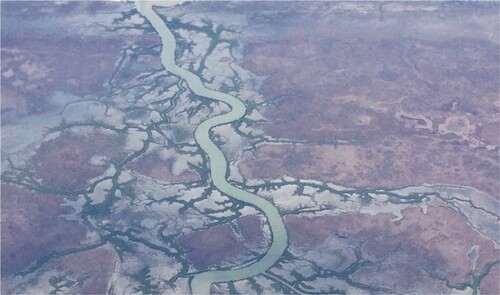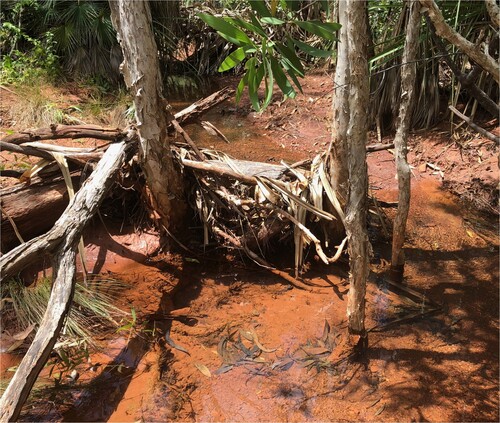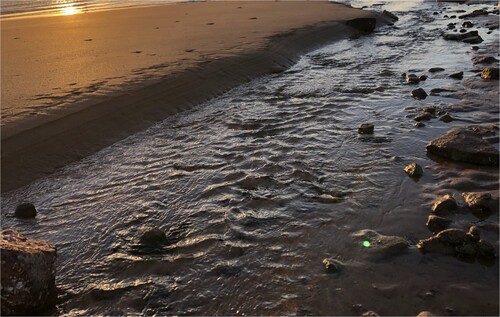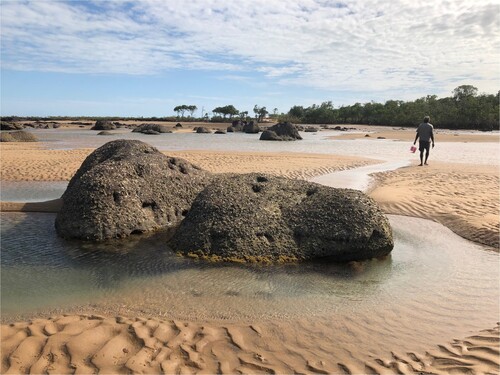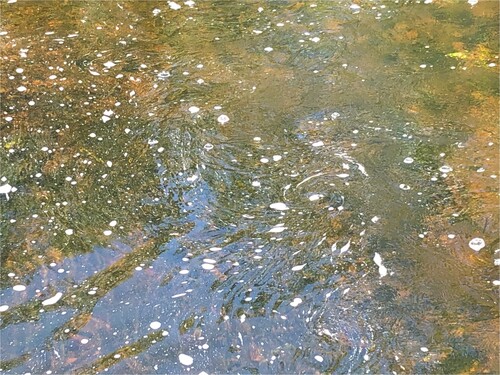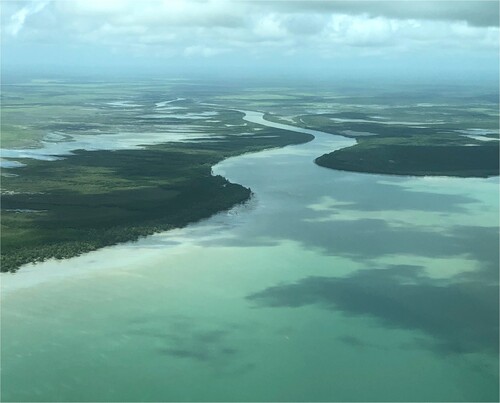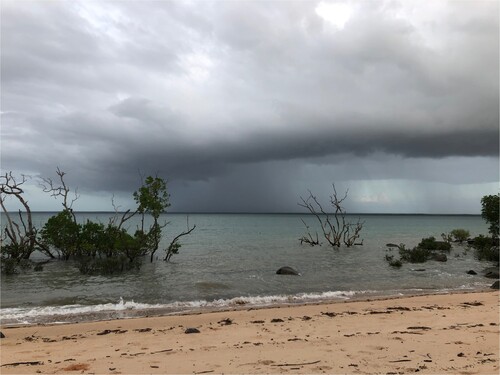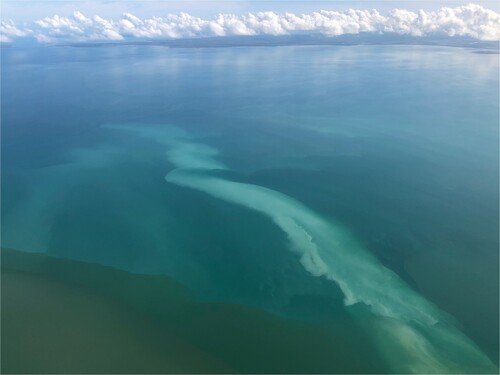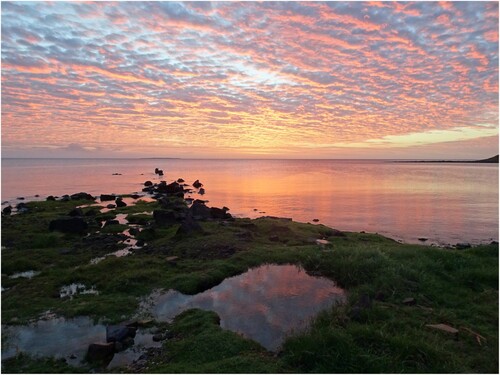ABSTRACT
Culture mediates how all people think and communicate and intercultural communication skills are required for effective collaboration. This study (2017–2021) explored intercultural communication with 40 participants in one very remote First Nations Australian community in Northern Australia. We explored the perspectives of both Yolŋu (First Nations Australian people from North-East Arnhem Land) and Balanda (non-Indigenous people, in this case Australian) on interactions during early childhood assessments of Yolŋu children (0–6 years). Our intercultural research team used a culturally responsive form of video-reflexive ethnography, a Yolŋu approach to in-depth discussion and collaborative analysis. In this article, we explore nine intercultural communication processes that were recognized and enacted by study participants. Each process is represented by a metaphor drawn from water traveling in North-East Arnhem Land. We share these processes so that others may consider exploring their relevance in other intercultural communication contexts.
Introduction
When people from different cultures meet, our relationships and collaborative partnerships depend on intercultural communication (Bawaka Country including Burarrwanga et al., Citation2018; United Nations Educational, Scientific and Cultural Organization [UNESCO], Citation2013). If we succeed in communicating well, our differences can support us in co-constructing transformative ways of working together (Sinclair, Citation2019b; UNESCO, Citation2013). This research explores processes for facilitating intercultural communication in a very remote First Nations AustralianFootnote1 community. Guided by the priorities of a group of local senior women, we used culturally responsive research methods to explore intercultural communication between Yolŋu and Balanda in contexts of early childhood (0–6 years) assessment interactions. Yolŋu are First Nations Australian people from the region that is now called North-East Arnhem Land in the Northern Territory of Australia. Balanda is a term used by speakers of Yolŋu languages to refer to non-Indigenous people.
Our research project explored the perspectives of both Yolŋu and Balanda communicators. We developed a theory of intercultural communication and Yolŋu researchers chose culturally resonant water metaphors to share our findings (see also Armstrong et al., Citation2023). Fresh water surfaces from underground springs representing culture and knowledge foundations; as it travels, water shapes natural objects such as stones and driftwood representing the way that experiences shape communicators; and fresh water meets the salt water and flows into the sea representing people from two different cultures meeting and finding a flow of communication. This article shares nine processes used by study participants to achieve an intercultural connection or a ‘flow that comes when we’re talking.’ Each process is represented by a metaphor drawn from the water’s journey through Yolŋu lands. These metaphors are intended to support readers to reflect on a Yolŋu way of conceptualizing intercultural communication and to explore the application of intercultural communication processes in their own contexts.
The cultural interface of this study
Australia is a colonized country where First Nations peoples hold unceded sovereignty (National Constitutional Convention, Citation2017). Intercultural communication happens at varied, complex, and multi-layered cultural interfaces (Nakata, Citation2007). Yolŋu hold rights and responsibilities to manage their own lands, waters, and communities (Northern Land Council, Citation2021). Despite being sovereign peoples of their lands, Yolŋu have little choice but to interact with white colonial Australian political, legal, and social systems (Moreton-Robinson, Citation2018).
The complexities and challenges of intercultural communication are highlighted daily at cultural interfaces in Yolŋu communities. A group of senior Yolŋu women raised concerns about communication between Yolŋu families and Balanda early childhood professionals. They perceived that early childhood programs and professionals coming to their community did not recognize and respect Yolŋu ways of raising children (Fasoli et al., Citation2019; Yalu’ Marŋgithinyaraw, Citation2012b). A subsequent study of Yolŋu child-rearing knowledges, skills, and priorities (Lowell et al., Citation2019) demonstrated that Balanda assessors risk missing or misinterpreting Yolŋu children’s strengths if they are not working in culturally safe partnerships with culturally connected Yolŋu experts (Armstrong, Maypilma, et al., Citation2022). In response, our research aimed to understand and facilitate intercultural communication between Yolŋu and Balanda specifically in contexts of early childhood (0–6 years) assessment interactions.
A review of literature relevant to this cultural interface
Culture mediates how all people think and know (Meyer, Citation2001; Wilson, Citation2008) and culture is incorporated in the languages and behaviors we use to think and to communicate (Armstrong, Gapany, et al., Citation2022; McLellan, Citation2010). When people from different cultures collaborate, intercultural communication is always a joint project between communicators (UNESCO, Citation2013) so it is necessary to explore the perspectives of all partners. Different ways of knowing, being, and doing are culturally shaped and, for many First Nations peoples, are fundamentally relational (Martin, Citation2008; Meyer, Citation2001; Wilson, Citation2008).
Yolŋu leaders and their intercultural partners have identified intercultural communication and shared understanding as key to effective interactions in health (Lowell et al., Citation2003; Lowell et al., Citation2021), education (Devlin & Gapany, Citation2017; Marika-Mununggiritj, Citation1991), law (Aboriginal Resource Development Services [ARDS], Citation2008), and research (Wright et al., Citation2012; Yalu’ Marŋgithinyaraw, Citation2012a). Miscommunication is prominent at such cultural interfaces and there is a need for greater understanding of collaborative, effective, respectful, and responsive ways of working across cultural differences (Armstrong, Maypilma, et al., Citation2022; Lowell et al., Citation2003; Yalu’ Marŋgithinyaraw, Citation2012b). In early childhood services, the cultural interface chosen for this study, practitioners are required to work flexibly with families in culturally responsive ways that demonstrate respect for diversity and for each child’s and family’s identity, languages, cultural practices, and values (Australian Children’s Education and Care Quality Authority [ACECQA], Citation2023; Australian Health Ministers’ Advisory Council [AHMAC], Citation2016; Early Childhood Intervention Australia [ECIA], Citation2016). Such partnerships require that both families and early childhood practitioners develop strong intercultural communication skills.
Literature suggests that there is no training or support currently available for Yolŋu families to learn how to communicate well with Balanda. While various cultural awareness and cultural competency programs are available for Balanda who work with First Nations Australians, practitioners at cultural interfaces rarely receive the ongoing support they need to navigate long-term relationships and complex processes of intercultural communication (Kerrigan et al., Citation2020; Sinclair, Citation2019a). Enacting processes of communication at complex cultural interfaces requires long-term engagement, deep reflection, relationships, and support (Armstrong, Gapany, et al., Citation2022; Kerrigan et al., Citation2020; Sinclair, Citation2019a; Walmsley et al., Citation2022). It is crucial for white communicators to acknowledge their unearned privilege and power and to recognize the racism built into systems in which they live and work (Worner & Wellington, Citation2022).
Centering Yolŋu intercultural communication knowledge shifts power to Yolŋu communicators and provides opportunities for Balanda communicators to engage with different ways of thinking about their roles in intercultural communication processes (Marika et al., Citation2009). Yolŋu metaphors, ‘drawn from the land, animals and the body, and handed down by the ancestors’ (Christie, Citation1994, p. 30), are central to Yolŋu knowledge systems and can be used to share and engage with different peoples’ perspectives on contemporary life (Christie, Citation1994). Yolŋu often use metaphors for intercultural knowledge-sharing, for examples see: Amery et al. (Citation2020); Ireland and Maypilama (Citation2021); Marika-Mununggiritj (Citation1991); and Marika et al. (Citation2009).
Consistent with Yolŋu methodologies and worldviews, throughout our project researchers connected emerging findings to metaphors chosen by Yolŋu researchers. This article shares water metaphors to represent intercultural communication processes that study participants identified as important to understand, reflect on, discuss, and enact. In the Findings section below are application examples from early childhood assessment interactions in health, allied health, education, and family support service contexts.
Research methods
Research setting
We conducted this study in Galiwin’ku, a very remote community on Elcho Island in the Arafura Sea, North-East Arnhem Land, Northern Territory (NT) of Australia. Galiwin’ku’s population is over 2200 and 94% of the population are Aboriginal and/or Torres Strait Islander people (Australian Bureau of Statistics [ABS], Citation2016). The most commonly spoken language is Djambarrpuyŋu and less than 5% of people speak English at home (ABS, Citation2016). However, English is used for interactions in most essential services across government, business, and not-for-profit sectors as many staff are not Yolŋu.
Research design
This qualitative, exploratory study followed culturally responsive research methods developed in Galiwin’ku (Yalu’ Marŋgithinyaraw, Citation2012a). It was designed, implemented, and disseminated collaboratively by a multicultural and multilingual research team, engaging Yolŋu and Balanda researchers who were committed to the topic, had relevant expertise and previous research relationships. A Ŋaraka-ḏälkunhamirr Mala (Backbone Committee), including senior members of the local Yolŋu community and Yolŋu leaders in early childhood services, advised researchers and contributed to data analysis.
The two-phase study occurred from 2017 to 2021. Phase 1 explored intercultural communication in five early childhood assessment interactions, as described below. In Phase 2 (Armstrong, Gapany, et al., Citation2022), we integrated and built on Phase 1 findings by co-creating and piloting an educational process to inform and facilitate intercultural communication in local health, education, and community service delivery contexts for all age groups.
Yolŋu and Balanda researchers worked together at an intercultural research interface: an innovative space for Indigenous methodologies to come together with compatible Western methodologies (Wilson et al., Citation2022). We analysed data collaboratively, respecting that people ‘tell the patterns within their own stories, in their own ways’ (Martin/Mirraboopa, Citation2003, p. 213). Researchers chose metaphors to share Phase 1 findings about foundational concepts that shape intercultural communication (Armstrong et al., Citation2023) and about processes that support the practice of intercultural communication (the focus of this article).
Ethical considerations
Our approach to research design and leadership reflects values and ethical principles required for research in First Nations Australian communities to redress social injustices, positioning First Nations peoples as leaders and partners in, not subjects of, research (Australian Institute of Aboriginal and Torres Strait Islander Studies [AIATSIS], Citation2020). The project was designed to address concerns identified by senior Yolŋu women and to be of benefit and value to the local community in tangible and agreed-upon ways (AIATSIS, Citation2020). Throughout the project, the intercultural research team reflected on our research methods, together and individually, in order to prioritize Yolŋu research processes for working ethically in Yolŋu communities over mismatched, non-Indigenous institutional processes (Armstrong et al., Citationin press). When research interfaces center the participating community’s perspectives, they can redress power imbalances and produce ‘relevant and meaningful research outcomes that are transformational’ (Wilson et al., Citation2022, p. 391).
Experienced Yolŋu researchers led and supervised the implementation of ethical research processes appropriate to this Yolŋu community. These processes included data collection and dissemination in participants’ first languages, seeking permission from knowledge holders and Yolŋu authorities before sharing cultural knowledge, and managing consent processes so that participants had choices between confidentiality or being publicly acknowledged for their contributions. Such processes facilitated rich and meaningful engagement and supported researchers and participants to maintain strong collaborative relationships throughout and beyond this five-year project (Armstrong et al., Citationin press).
Charles Darwin University Human Research Ethics Committee (H18063) approved this project. The Northern Territory Government Department of Education Research Subcommittee (Ref 14505) and the Galiwin’ku Regional Council Local Authority (Meeting 11 April 2018) supported the project. Researchers obtained permits from the Northern Land Council.
Participants
The 40 participants were seven Yolŋu children (aged 0–6 years); 10 of their family members (including mothers, grandmothers, father, grandfather, aunt, and kinship carer); 10 Yolŋu service providers; 6 Balanda service providers; 1 service provider from another First Nations Australian background; 5 Yolŋu researchers and interpreters; and 1 Balanda researcher. Researchers and interpreters who contributed to data collection and provided insights during transcription were included as participants because their perspectives were also recorded as data (see supplementary material Table 1). The project was explained to participants in their preferred language and adults gave their written informed consent for themselves, and their children where appropriate, to participate. Children were aware that they were being videoed or audio recorded with their family members.
Data collection
Prior to assessment interactions, 17 semi-structured discussions were recorded with participants individually, in pairs or small groups, to explore their experiences communicating with people from different cultural backgrounds and their expectations of early childhood assessment interactions. Five early childhood assessment interactions were then recorded by participants using video and/or audio equipment provided by researchers.Footnote2 Children (0–6 years) who attend early childhood services in Galiwin’ku participate in assessment processes using a variety of assessment tools.Footnote3 Participants recorded their own routine early childhood assessment practices. The processes, purposes, tools, timing, and contexts (school, clinic, home, or service provider office) were different in each interaction recorded.
Each participant involved in the assessment interaction was invited to individually review and analyse the communication within their own recording using a culturally congruent form of video-reflexive ethnography (Iedema et al., Citation2018; Lowell et al., Citation2005) and a Yolŋu approach to in-depth discussion: waŋanhamirr bala-räliyunmirr. Members of all five families participated in this phase of data collection; eight service providers participated in analysis of recordings and two (one Balanda, one Yolŋu) declined to view and analyse the recordings of themselves but gave consent for others to analyse them.
Discussions (25–94 min) were recordedFootnote4 where participants preferred to meet (e.g. in workplaces, at home on verandas, or under the shade of a tree) and researchers provided refreshments. Participants and researchers chose which languages they preferred to speak. Most data were recorded in Djambarrpuyŋu, less in English, reflecting the fact that only seven of the forty participants spoke English as a first language. One researcher used her own language, Warramiri, during discussions. Most data were transcribed in English, with keywords, phrases, and concepts written in Yolŋu languages to preserve their meaning and support shared understanding (see supplementary material Table 1 for examples).
Data analysis
We analysed data collaboratively using inductive methods aligned with a constructivist grounded theory approach (Charmaz, Citation2014). Others working at research interfaces have also found constructivist grounded theory to be compatible with Indigenous methodologies when used in collaborative, culturally, and linguistically responsive ways (Lyons et al., Citation2022; Wilson et al., Citation2022). Emily and Yolŋu researchers worked together on data analysis iteratively throughout most of the study and supplementary material (Table 1) provides examples of our intercultural collaborative processes. When necessary, due to restrictions associated with the COVID-19 pandemic, we used an online meeting platform (Zoom) to conduct collaborative analysis. Data were organized using qualitative data management software QSR Nvivo12 (QSR International, Citation2018) and hand coding.
First, participants’ words and phrases were used to create initial codes. Working together, Yolŋu and Balanda researchers then grouped codes into conceptual categories using focused coding and constant comparative analysis (Charmaz, Citation2014). Some codes and conceptual categories were in Djambarrpuyŋu and some were in English because some words and concepts were difficult to translate between languages. We discussed deeper meanings of these concepts in Yolŋu languages and English; we added researcher discussions to our data (see supplementary material Table 1 for an example). Emerging categories and key codes were reviewed and discussed with available participants for refining and confirmation.
From connected conceptual categories, we built a theory of intercultural communication and a water metaphor to communicate our findings. The cultural and linguistic expertise of senior Yolŋu researchers has been foregrounded in this process. Yolŋu researchers enacted cultural protocols in selecting a metaphor and sharing Yolŋu dhäwu (stories), including authorization by waṯaŋu mala (custodians of this knowledge) and support and guidance from a djuŋgaya (executor or manager of this knowledge). Researchers worked together to choose words and place-based images to share this metaphor with support from research advisors. We share surface stories about the way the water flows to represent our findings but the deeper stories, embedded in Yolŋu law and protocol, and are not suitable to share in the context of this article.
Findings
Our findings about communication between Yolŋu and Balanda participants are represented through water metaphors. Water tells a story about intercultural communication processes as the raypiny gapu (fresh water) flows from a spring, along waterways and rivers, meets the moṉuk gapu (salt water), and then flows out into the sea. Using this metaphor, we describe nine key processes in the water’s flow aligned with nine conceptual categories from research findings about intercultural communication. We illustrate these processes with photographs taken by Emily in North-East Arnhem Land. For each conceptual category, we provide examples of how participants navigated these communication processes in early childhood assessment interaction contexts (see also supplementary material Table 2). These examples are intended to illustrate the concepts, but they are neither prescriptive nor exhaustive.
Water travels from many places like knowledge from many clans. Water can nourish as it travels. Water carries identity, language, and authority for the people who live on the land. It can give strength to stand strong but it cannot travel without authority. As the water travels through the lands of different clans, it follows songlines and carries languages – each clan from each place sings a different language. If you travel through different lands, you need to learn people’s different ways of communicating at each step.
When the fresh water meets the salt water, it swirls around and creates bubbles and white froth. When you see the froth, that’s when people from different cultural groups are talking over the knowledge. And then, if and when they come to an agreement or an understanding, the water flows to calm, to quiet, to the sea. The water’s journey is healing and the action of communicating can be healing too.
Manamanapanmirr ŋuli yaŋara gapu bala wanganylila ganhaganhamirr – combining small streams together into one
The water’s journey begins with the little streams and spring waters that come from different places as each person brings specific knowledges and practices (small streams) to an interaction. When small streams from each person flow together they form bigger streams representing the beginning of an intercultural communication process (see ). In discussing early childhood assessment interactions, all participants talked about children’s gradual development of skills. Participants differed in which skills they focused on and how they discussed components within these skills. We found the ways that participants analysed children’s development varied depending on both culture and individual experiences. Additionally, participants’ cultural lenses determined which skills they broke into components and which they held holistically (e.g. Yolŋu participants analysed components of the gurruṯu (kinship) system; Balanda participants analysed components of reading).
For example, participants recorded an activity in which a six-year-old child listened to a Yolŋu assistant teacher (AT) read a book and then talked with the AT about the book – both the book and the discussion were in Djambarrpuyŋu. Five different participants focused their analyses on five different skills: the Yolŋu assistant teacher (AT) analysed the child’s advanced knowledge of the book content (animal habitats); the child’s mother commented on the child’s kinship connection to the Yolŋu AT and was proud of her child’s development of reading Djambarrpuyŋu text; a Balanda teacher discussed components of literacy (e.g. phonological awareness); a teacher from another First Nations Australian background analysed the child’s development of receptive language skills; and a speech pathologist commented on the child’s strong auditory memory.
Such different analyses can be sources of misunderstanding but they can also be sources of learning and rich discussion. In the above example, participants did not come to a shared understanding of what was being assessed in the book-reading activity. However, by using literacy resources in the child’s first language that are relevant to her family’s everyday experiences in this community context, they were able to bring their perspectives together and start a discussion:
She picked up the story [in the Djambarrpuyŋu book] quickly – maybe because she goes out with her mother and family hunting or to the beach and they also live in the outstation. (Yolŋu Assistant Teacher)
Nhaltjan nhe dhu ḻiwu’yun marrtji ŋunhi dhu gulmaram dhukundhuny – how you find another pathway for your work so it can keep flowing when something’s in the way
All participants and researchers experienced barriers, confusion, and miscommunication. Participants discussed strategies for working around barriers, as a stream finds a pathway to keep flowing when debris is in the way (see ). It is important for partners with different cultural perspectives to work together to understand the underlying reasons for barriers to the flow of intercultural communication – like digging down under the water to find out what is blocking the flow of a stream. Identifying an underlying barrier together allowed some participants to keep working together to find new ways for the communication to flow.
Some participants did not communicate with each other about their perspectives on barriers during their interactions and therefore their plans for how to work around those barriers did not align. For example, despite nodding when the health workers spoke, it became apparent that a Yolŋu mother did not understand the purpose of her child’s assessment. The Balanda service provider interpreted this miscommunication as meaning that the team needed to improve their health education processes. However, the Yolŋu service provider explained that it was not about the content of the education but who was providing it – she was not comfortable talking with this mother, nor with the child’s grandmother who was also in the room, because she has respectful avoidance kinship relationships with them.
The ways around a barrier depend on what the barrier is and who is trying to keep the communication flowing. Participants shared some strategies for finding ways around barriers together including: letting go of control and being quiet so that other people can talk; seeing what communication partners do do rather than focusing on what they don’t do; prioritizing continuity of care so that partners can build and maintain relationships; discussing each others’ understandings of key words and concepts; and thinking about what is missing from the conversation and what is not being discussed. Asking another person to support communication is often a useful way around a communication barrier, for example: an interpreter; a person with the right relationships to communicators; or someone to talk to when you are finding communication challenging.
Dhäkay-ŋama manymak – feeling connected and flowing smoothly
Participants described aiming for dhäkay-ŋama manymak in their intercultural communication. Dhäkay-ŋama manymak is a Yolŋu idiom (literally translated as ‘good taste-listening’) meaning feeling connected and flowing smoothly – like water traveling in a stream (see ). Participants aimed to achieve a smooth flow of intercultural communication demonstrated in body language, facial expressions, spoken language, voice tones, and strong relationships. When people achieved this flow of communication, they described it as feeling gentle, steady, easy, and smooth. As one Yolŋu researcher said, ‘it feels as though the water itself knows where to go’.
It’s the way of connecting – if you’re on the right track, you can feel that word dhäkay-ŋama manymak. You feel good about yourself and see the audience connected and they feel the message, it’s flowing smoothly in their ŋayaŋu (inner being). And they feel that there’s something there that they can achieve together with you … it’s coming to one common ground, what we’re talking about, what we’re on about. (Dorothy Gapany, Yolŋu Researcher)
Galkun ga dhukarrwu mala-djarryunharaw – waiting to sort out the right time and path
Yolŋu learn by the moon, seasons, and tides when is the right time to go out hunting or fishing (see ). This is a metaphor for the way research participants described watching and listening carefully to get a sense for when is the right time to gather knowledge or take action. Waiting is itself a very important part of intercultural communication because it creates time for observing, learning, reflecting, and connecting to the environment and people around you. The communication cues and signs for when to wait and when to act are different in Yolŋu and Balanda cultures and in different contexts. Participants described their ongoing learning about how to observe and interpret these cues and signs.
I think that’s just different cultural cues that we use, and we [non-Indigenous people] probably do things in really bad timing. We probably look really clumsy with our timing to Yolŋu. [We should] look further into what are some cues of when is a good time. (Balanda Teacher)
Manapanmirr ŋayaŋu – putting your hearts together
When the time is right and people are well connected and working well together, we come to manapanmirr ŋayaŋu (putting your hearts together). This concept is represented by places where the tide is changing and the fresh water and salt water are meeting together and combining (see ). Manapanmirr ŋayaŋu happens when people from different cultures are feeling connected enough to be ready to open up and tell the stories that are really important to them. As well as creating spaces where people feel comfortable to talk about their hopes and plans, this concept encapsulates the communication behaviors required to move plans into action. For example, when multilingual teams meet together for goal setting and planning, using multiple languages supports manapanmirr ŋayaŋu:
Instead of speaking English, someone is there speaking to the Balanda teachers in Yolŋu Matha (Yolŋu languages) and if they don’t understand someone explains to them. It’s the same for the Balanda, they do the same and if we don’t know the big words [in English] they will explain to us to help us understand. Sharing. (Yolŋu Assistant Teacher)
Buḻarrmaraŋ dhäwu – expanding the story
When the river mouth opens out into the wider sea (see ), it represents buḻarrmaraŋ dhäwu (expanding the story). The river has cleared out all the dhukun (debris) that was being carried in the water and now it is clear and calm. During this process of intercultural communication, people are able to listen and understand more deeply what is being said. Partners may discuss concepts that were previously hidden or unrecognized. Participants talked about moving beyond the surface connection, exploring deeper meanings together in the right environment with the right people, understanding a wider picture, and building a more connected way of thinking.
We [Yolŋu Community Workers] went, sat with family. Not inside. Outside. … Like we are now, sitting under the tree. Because the health is outside. How will we fix people inside there [in the clinic], while the diseases are out here? … tell the deeper story in giving education. (Retired Yolŋu Community Worker)
Ŋayaŋuŋur ga dhawaṯthun limurruŋgal – coming out from within us
To understand this process, picture dark clouds coming towards you and starting to rain as the tide is coming in and touching the mangroves (see ). You might feel the rain is coming out from within you as you are showing and expressing yourself. Sometimes stories are being held tightly by people and not expressed and then they might suddenly burst forth like a sharp downpour from heavy clouds. Sometimes people feel comfortable to express themselves and ask questions and share what they really think and that can be like soothing, steady rain.
I’ve got a [colleague] here at the moment, which has been awesome because normally I’ve got no one to really talk to about some of the issues that come up here, and there’s a lot that come up here, and really troublesome stuff. So that’s been really good to talk to her about it. But she’s an agency staff [member] – coming and going. So it’s been hard in that way, and I didn’t realise how isolated I have felt in that light until she came and I was like ‘blagh!’ I’ve realised that I was struggling. (Balanda Health Professional)
Dharrwa djatja mala limurr ŋuli dharaŋaŋ – recognizing many currents
Our research demonstrated that there are always different layers of communication happening like many separate currents of water flowing alongside each other, under and over each other. Different layers of communicating are represented by dharrwa djatja mala (many currents) in the water which has now flowed out into the deeper sea (see ). We found that, even for intercultural partners who have been working together for a long time, it was important not to assume a shared understanding or assume that they communicate in the same way. When different layers of communication were not recognized or explored, some participants reported feeling lost, confused, deceived, or misled because ‘the story is telling lies.’
When people were saying the same words, we found that they often had different understandings of what they meant because of their different experiences and different languages.
Because of the way she said it – so her sentence and her voice is a different sound. The deeper tone of her voice changes her meaning. … because we know [the speaker] is an Elder of the community who has been through a whole lot of things. Whereas the mum is a young mum who hasn’t been through all those things, all that learning … So they’re not on the same level when they talk. … She is not thinking with a tone like [the Elder]. (Rachel Dikul Baker, Yolŋu Researcher and Interpreter)
Dhuwurr milkunhamirr nhunapinya nhe – ways of presenting yourself
Dhuwurr is about ‘showing who you really are’ and what you represent. How your intercultural communication partners connect and respond to you can be a reflection of your dhuwurr. We represent this concept with the sun shining on the sea like the light of someone’s personality, and being reflected back by other people’s responses like the colors of the clouds are reflected on the sea at sunset (see ).
Intercultural partners talked about how they see, hear, and feel each other interact in many different situations around the community and how people show their genuine identities and personalities through their communication styles. Participants described some of the personal characteristics that facilitated strong intercultural communication in this context. Examples included being gurrum’ (gentle), being ḏamba ḏamba (light, alert), being ralpa (responsive, willing), ‘being real’, ‘mirroring of body language’, being positive, expressing excitement, being open to try new things, and putting Yolŋu staff in front, not behind Balanda.
It makes the communicating better because of flexibility and ralpa (responsive, willing) and ḏamba ḏamba (light, alert) … they’re connecting. (Yolŋu Assistant Teacher)
You want to work with someone ḏamba (light, alert), you don’t want to work with someone heavy, you don’t get results or efficiency. You get more results with someone who is ḏamba ḏamba. (Rachel Dikul Baker, Yolŋu Researcher and Interpreter)
Discussion
We conducted our study with a Yolŋu community on Yolŋu land: respect for Yolŋu sovereignty is demonstrated through the leadership of Yolŋu researchers and centering of Yolŋu knowledges in this research. In this section of the paper, we will discuss our work’s theoretical and methodological contributions, and implications for practice both in early childhood contexts and more broadly.
A Yolŋu way of conceptualizing intercultural communication: foregrounding Yolŋu theoretical and methodological contributions
While our research includes the perspectives of both Yolŋu and Balanda communicators, the metaphors shared in this article foreground Yolŋu knowledges and Yolŋu places. Yolŋu ways of understanding connections and relationships are strengths that have supported many generations to maintain strong identities and facilitate intercultural communication with visitors to Yolŋu lands and waters. Focusing on such strengths and assets can shift and change narratives, providing ways to deal with issues of concern and creating opportunities to facilitate growth and wellbeing in First Nations Australian communities (Fogarty et al., Citation2018).
The Gaṉma metaphor, about two different cultures meeting as fresh and salt water meet, comes from Yolŋu knowledges passed down by ancestors and has been written about before (Laycock et al., Citation2011; Marika-Mununggiritj et al., Citation1992; Marika, Citation1999). The nine key processes we have shared in this article are our own application of this Gaṉma metaphor in a contemporary intercultural communication context to reveal important ways of seeing, hearing, understanding, and responding to people from different cultures through ongoing relationships, reflection, and collaboration. Our use of water metaphors to represent intercultural communication processes may be new to many readers. The metaphors used in our team’s work support Yolŋu to connect our research to Yolŋu knowledge, and Balanda to connect our research to Balanda knowledge, in new and useful ways (Armstrong, Gapany, et al., Citation2022). We have shared these processes through metaphor to prompt discussion so that others may explore their resonance and application in different contexts. We have also co-created an educational process and multi-media resources which support both Yolŋu and Balanda communicators to engage with and explore our research findings (Armstrong, Gapany, et al., Citation2022).
In deciding which cultural knowledge was appropriate to share through our intercultural communication theory, Yolŋu authors drew on knowledge passed down to them personally and also sought support from other knowledge holders. For example, while working on our data analysis, senior Yolŋu researchers frequently referred to a video recording of three senior Yolŋu men singing and talking about Yirritja water (Ŋurruwutthun et al., Citation1997). In this video, the men sing and speak in Warramiri language about how water connects to land and people and carries deep knowledge on its journey from fresh water to salt water. Two authors of this paper, Ḻäwurrpa and Yuŋgirrŋa, view Elders such as these men as being like supervisors for them as Yolŋu researchers.
Our methodology and findings may be useful for others undertaking collaborative research which centers First Nations Australian knowledges and practices. Ethical principles for research in First Nations Australian communities require that First Nations people control research processes and benefit from the outcomes (AIATSIS, Citation2020). Our team drew from both a Yolŋu research paradigm and a transformative research paradigm, but privileged Yolŋu ways of knowing, being, and doing intercultural communication research. Yolŋu and Balanda researchers worked reflexively and collaboratively throughout all stages of the research, from conceptualization with senior Yolŋu women to dissemination through water metaphors, ‘coproducing what it means to decolonize research in a multiparadigmatic approach’ (Held, Citation2019, p. 11).
Our team used culturally responsive research methods which supported Yolŋu partners to expand the story (buḻarrmaraŋ dhäwu) and thereby bring old Yolŋu knowledges into new academic places (Kovach, Citation2010). When collaborative methods center First Nations knowledges, non-Indigenous researchers may find, as members of our team did, that their own understandings of the research topic are deepened and stretched in unexpected ways. This stretching and learning process can be both rich and challenging. In research, as in practice, intercultural partners may put their hearts together (manapanmirr ŋayaŋu) and experience dhäkay-ŋama manymak (feeling connected and flowing smoothly) and they may also encounter many communication barriers and blockages, at both personal and systemic levels. It is important for intercultural research partners to work together to find pathways around blockages (nhaltjan nhe dhu ḻiwu’yun marrtji ŋunhi dhu gulmaram dhukundhuny), so that their collaborative work can continue to flow towards transformational outcomes in local communities and in academia (Bawaka Country including Burarrwanga et al., Citation2017; Held, Citation2019; UNESCO, Citation2013; Wilson et al., Citation2022). Allowing time for waiting to sort out the right time and path has deep methodological importance in this kind of research.
Practical implications: application of intercultural communication processes in early childhood contexts and beyond
Intercultural communication, by nature, is shaped by the cultural foundations, identities, and experiences each communicator brings to the interaction (Armstrong et al., Citation2023): it is therefore different in different places, between different cultural groups and between different people. All children and families have the right to practice and enjoy their own culture, use their own language, and have their language, culture, and values respected – the rights of Indigenous peoples to do so are highlighted Article 30 of the United Nations (Citation1989) Convention on the Rights of the Child. In contexts of early childhood assessment interactions, intercultural communicators need to uphold these rights and challenge culturally mismatched systems which are imposed upon First Nations communities in colonized countries (Armstrong, Maypilma, et al., Citation2022).
If communicators aim to ‘co-create expertise’ (Hughes & MacNaughton, Citation1999, p. 31) with partners from a different cultural background to their own, it is useful to begin by exploring one’s own underlying cultural assumptions. Cultural assumptions underly knowledges and practices and interact with the communication processes we have shared in this article. Joint reflection on children’s skills, for example, is one method for families and early childhood educators to connect their culturally specific knowledges and practices as illustrated in the combining small streams together into one section of our findings. Through this process ‘an interpretive community, i.e. a community based on shared (negotiated) understandings of … the child’ (Hughes & MacNaughton, Citation2002, p. 18) can be built. Our findings suggest that, when undertaking such joint reflection, it is important not to pre-structure discussions based on one partner’s assumptions. Instead, it is useful to create communication spaces which support people to express themselves (ŋayaŋuŋur ga dhawaṯthun limurruŋgal), seek to expand the story (buḻarrmaraŋ dhäwu), and recognize multiple layers of different meaning contained within communication modalities (dharrwa djatja mala limurr ŋuli dharaŋaŋ).
Researchers in other intercultural communication contexts have also discussed concepts similar to those shared here. For example, Bawaka Country including Burarrwanga et al. (Citation2018) emphasize the importance of slowing down, waiting, and taking time in intercultural communication: ‘sensing, attending and being patient’ (p. 28). The importance of expanding the story and deepening shared understandings has been emphasized by teams working on health education in Yolŋu communities, such as Lowell et al. (Citation2021). van Gelderen and Guthadjaka (Citation2019) describe using ‘from Country’ and ‘through Country’ pedagogy to teach school students about the many layers of learning communicated by Warramiri land and seasons.
Our findings demonstrate the importance of intercultural communicators showing who they are and what they represent (dhuwurr milkunhamirr nhunapinya nhe) so that others can connect and respond. This process supports intercultural communication partners to build genuine relationships which are widely recognized as essential for the co-construction of transformative ways of working together, both in early childhood contexts and more broadly (Bawaka Country including Burarrwanga et al., Citation2018; Burton, Citation2012; Marika et al., Citation2009; Darug Ngurra et al., Citation2021; Sinclair, Citation2019b; UNESCO, Citation2013). As Wilson (Citation2008) wrote of an Indigenous ontology and epistemology, ‘relationships do not merely shape reality, they are reality’ (p. 7). Our findings include nine processes for building intercultural relationships and achieving a flow of communication during early childhood assessment interactions. These processes facilitate shared understanding between people from Yolŋu and Balanda cultures. The metaphors we have shared may prompt discussion and exploration by intercultural communicators from other lands and waters.
Conclusion
Our study explored intercultural communication using culturally responsive methods which created opportunities for people to share their perspectives in their own ways through their own languages. A collaborative approach to analysis supported the emergence of a theory of intercultural communication represented holistically through metaphor to maintain connection with the people, lands and waters from which it emerged. Our work foregrounds a Yolŋu way of conceptualizing intercultural communication with theoretical, methodological, and practical implications both in early childhood contexts and more broadly. We hope that discussing the processes shared in this article may support you and your partners to communicate well as you navigate the waters of your own cultural interfaces – djäma rrambaŋi (working together).
Supplemental Material
Download Zip (1 MB)Acknowledgements
This article is part of Emily Armstrong’s doctoral research project which has been shared at multiple conference workshops and presentations. We thank the participants, researchers, and Yolŋu knowledge holders who contributed to this collaborative work. Yalu Aboriginal Corporation provided a space in Galiwin’ku for researchers to meet and work.
Disclosure statement
No potential conflict of interest was reported by the authors.
Additional information
Funding
Notes
1 First Nations Australians is used in this article to include diverse Aboriginal and Torres Strait Islander peoples in Australia who hold unceded sovereignty over their lands and waters.
2 In accordance with family preferences, four interactions were video and audio recorded and one interaction was audio recorded only.
3 Assessment tools used in our sample included: ASQ-TRAK (Ages and Stages Questionnaire – Talking About Raising Aboriginal Kids) (D'Aprano et al., Citation2016); classroom-based summative assessment for the purposes of twice-yearly reporting aligned with the Australian Curriculum (Australian Curriculum Assessment and Reporting Authority [ACARA], Citation2018); Healthy Under Five Kids (HU5K) schedule (Kruske et al., Citation2009); and Play and Learn Support (PALS) resource kit (Anglicare, Citation2012) to support conversations about child development.
4 According to participant preference, discussions were audio-recorded (n = 24), video and audio-recorded (n = 4) or recorded with written notes (n = 1).
References
- Aboriginal Resource and Development Services. (2008). An absence of mutual respect: Bäyŋu ŋayaŋu-ḏapmaranhamirr Rom ga ŋorra. Aboriginal Resource Development Services. https://www.ards.com.au/resources-2/legal
- Amery, R., Wunungmurra, J. G., Gondarra, J., Gumbula, F., Raghavendra, P., Barker, R., Theodoros, D., Amery, H., Massey, L., & Lowell, A. (2020). Yolŋu with Machado-Joseph disease: Exploring communication strengths and needs. International Journal of Speech-Language Pathology, 22(5), 499–510. https://doi.org/10.1080/17549507.2019.1670863
- Anglicare, N. T. (2012). Play and Learn Support (PALS) resource kit. Anglicare NT.
- Armstrong, E., Gapany, D., Maypilama, Ḻ, Bukulatjpi, Y., Fasoli, L., Ireland, S., & Lowell, A. (2022). Räl-manapanmirr ga dhä-manapanmirr – Collaborating and connecting: Creating an educational process and multimedia resources to facilitate intercultural communication. International Journal of Speech-Language Pathology, 24(5), 533–546. https://doi.org/10.1080/17549507.2022.2070670
- Armstrong, E., Maypilama, Ḻ, Bukulatjpi, Y., Gapany, D., Fasoli, L., Baker, D. R., Ireland, S., & Lowell, A. (in press). Räl-manapanmirr djämaw – Collaboration in action. Learning Communities: International Journal of Learning in Social Contexts.
- Armstrong, E., Maypilama, Ḻ, Bukulatjpi, Y., Gapany, D., Fasoli, L., Ireland, S., Baker, R. D., Hewat, S., & Lowell, A. (2023). Nhaltjan dhu ḻarrum ga dharaŋan dhuḏi-dhäwuw ŋunhi limurr dhu gumurrbunanhamirr ga waŋanhamirra, Yolŋu ga Balanda: How we come together to explore and understand the deeper story of intercultural communication in a Yolŋu (First Nations Australian) community. AlterNative: An International Journal of Indigenous Peoples. Advance online publication. https://doi.org/10.1177/11771801231169337
- Armstrong, E., Maypilma, Ḻ, Fasoli, L., Guyula, A., Yunupiŋu, M., Garratju, J., Gundjarranbuy, R., Gapany, D., Godwin-Thompson, J., & Lowell, A. (2022). How do Yolŋu recognise and understand their children’s learning? Nhaltjan ŋuli ga Yolŋuy nhäma ga märr-dharaŋan djamarrkuḻiw marŋgithinyawuy? PLOS ONE, 17(8), e0272455. https://doi.org/10.1371/journal.pone.0272455
- Australian Bureau of Statistics. (2016). 2016 Census: QuickStats: Galiwinku. Retrieved September 4, 2021, from http://www.censusdata.abs.gov.au/census_services/getproduct/census/2016/quickstat/SSC70106
- Australian Children’s Education and Care Quality Authority. (2023). Guide to the National Quality Framework. https://www.acecqa.gov.au/nqf/about/guide
- Australian Curriculum Assessment and Reporting Authority. (2018). Australian Curriculum: Foundation – Year 10 (Version 8.4). https://www.australiancurriculum.edu.au/f-10-curriculum/
- Australian Health Ministers’ Advisory Council - National Aboriginal and Torres Strait Islander Health Standing Committee (NATSIHSC). (2016). Cultural respect framework 2016–2026 for Aboriginal and Torres Strait Islander Health: A national approach to building a culturally respectful health system. https://nacchocommunique.com/tag/national-cultural-respect-framework-for-aboriginal-and-torres-strait-islander-health-2016-2026/
- Australian Institute of Aboriginal and Torres Strait Islander Studies. (2020). AIATSIS code of ethics for Aboriginal and Torres Strait Islander research. https://aiatsis.gov.au/sites/default/files/2020-10/aiatsis-code-ethics.pdf
- Bawaka Country including Burarrwanga, L., Ganambarr, R., Ganambarr-Stubbs, M., Ganambarr, B., Maymuru, D., Lloyd, K., Wright, S., Suchet-Pearson, S., & Hodge, P. (2017). Meeting across ontologies: Grappling with an ethics of care in our human-more-than-human collaborative work. In J. Haladay & S. Hicks (Eds.), Narratives of educating for sustainability in unsustainable environments (pp. 144–157). Michigan State University Press.
- Bawaka Country including Burarrwanga, L., Ganambarr, R., Ganambarr-Stubbs, M., Ganambarr, B., Maymuru, D., Suchet-Pearson, S., Wright, S. L., Lloyd, K., Tofa, M., & Daley, L. (2018). Intercultural communication handbook. The Bawaka Collective. http://bawakacollective.com/handbook/
- Burton, J. (2012). Opening doors through partnerships: Practical approaches to developing genuine partnerships that address Aboriginal and Torres Strait Islander community needs. Secretariat of National Aboriginal and Islander Child Care. https://www.snaicc.org.au/wp-content/uploads/2016/01/02804.pdf
- Charmaz, K. (2014). Constructing grounded theory (2nd ed). Sage.
- Christie, M. (1994). Grounded and ex-centric knowledges: Exploring Aboriginal alternatives to western thinking. In J. Edwards (Ed.), Thinking: International interdisciplinary perspectives (pp. 24–34). Hawker Brownlow Education.
- D'Aprano, A., Silburn, S., Johnston, V., Robinson, G., Oberklaid, F., & Squires, J. (2016). Adaptation of the Ages and Stages Questionnaire for remote Aboriginal Australia. Qualitative Health Research, 26(5), 613–625. https://doi.org/10.1177/1049732314562891
- Darug Ngurra, Dadd, L., Norman-Dadd, C., Graham, M., Suchet-Pearson, S., Glass, P., Scott, R., Narwal, H., & Lemire, J. (2021). Buran Nalgarra: An Indigenous-led model for walking with good spirit and learning together on Darug Ngurra. AlterNative: An International Journal of Indigenous Peoples, 17(3), 357–367. https://doi.org/10.1177/11771801211023210
- Devlin, N. R. F., & Gapany, D. (2017). Reminiscences: Working together in a bilingual classroom. In B. Devlin, S. Disbray, & N. R. F. Devlin (Eds.), History of bilingual education in the Northern Territory (pp. 325–330). Springer. https://doi.org/10.1007/978-981-10-2078-0_26
- Early Childhood Intervention Australia. (2016). The national guidelines for best practice in early childhood intervention (1st ed.). Early Childhood Intervention Australia. https://re-imagine.com.au/practitioner/what-is-best-practice/
- Fasoli, L., Maypilama, L., Lowell, A., Guyula, Y., Gundjarranbuy, R., Yunupiŋu, M., & Farmer, R. (2019). We’re still being dragged to be white: Learning from Yolŋu growing up their children in two worlds. In A. Pence & J. Harvell (Eds.), Pedagogies for diverse contexts (pp. 78–94). Routledge.
- Fogarty, W., Lovell, M., Langenberg, J., & Heron, M.-J. (2018). Deficit discourse and strengths-based approaches: Changing the narrative of Aboriginal and Torres Strait Islander health and wellbeing. The Lowitja Institute. https://www.lowitja.org.au/page/services/resources/Cultural-and-social-determinants/racism/deficit-discourse-strengths-based
- Held, M. B. E. (2019). Decolonizing research paradigms in the context of settler colonialism: An unsettling, mutual, and collaborative effort. International Journal of Qualitative Methods, 18, 160940691882157. https://doi.org/10.1177/1609406918821574
- Hughes, P., & MacNaughton, G. (1999). Who’s the expert: Reconceptualising parent-staff relations in early education. Australasian Journal of Early Childhood, 24(4), 27–32. https://doi.org/10.1177/183693919902400406
- Hughes, P., & MacNaughton, G. (2002). Preparing early childhood professionals to work with parents: The challenges of diversity and dissensus. Australasian Journal of Early Childhood, 27(2), 14–20. https://doi.org/10.1177/183693910202700204
- Iedema, R., Carroll, K., Collier, A., Hor, S.-y., Mesman, J., & Wyer, M. (2018). Video-reflexive ethnography in health research and healthcare improvement: Theory and application. CRC Press. https://doi.org/10.1201/9781351248013
- Ireland, S., & Maypilama, E. L. (2021). ‘We are sacred’: An intercultural and multilingual approach to understanding reproductive health literacy for Yolŋu girls and women in remote Northern Australia. Health Promotion Journal of Australia, 32(S1), 192–202. https://doi.org/10.1002/hpja.439
- Kerrigan, V., Lewis, N., Cass, A., Hefler, M., & Ralph, A. P. (2020). ‘How can I do more?’ Cultural awareness training for hospital-based healthcare providers working with high Aboriginal caseload. BMC Medical Education, 20(1), 173. https://doi.org/10.1186/s12909-020-02086-5
- Kovach, M. (2010). Conversational method in Indigenous research. First Peoples Child & Family Review, 5(1), 40–48. https://fpcfr.com/index.php/FPCFR/article/view/172/141. https://doi.org/10.7202/1069060ar
- Kruske, S., Donovan, J., McKinnon, T., & Nuttall, L. (2009). Healthy under five kids: Education package. Charles Darwin University and NT Department of Health and Families. https://digitallibrary.health.nt.gov.au/prodjspui/handle/10137/424
- Laycock, A., Walker, D., Harrison, N., & Brands, J. (2011). Researching Indigenous health: A practical guide for researchers. The Lowitja Institute. https://www.lowitja.org.au/page/services/resources/health-policy-and-systems/aboriginal-and-torres-strait-islander-leadership/Researching-Indigenous-Health-Guide
- Lowell, A., Brown, I., Marrŋanyin, B., Flack, M., Christie, M., Snelling, P., & Cass, A. (2005). Sharing the true stories: Improving communication between health staff and Aboriginal patients, stage 1, interim project report. Cooperative Research Centre for Aboriginal Health. https://www.cdu.edu.au/centres/stts/home.html
- Lowell, A., Maypilama, E., & Biritjalawuy, D. (2003). Indigenous health and education: Exploring the connections. Cooperative Research Centre for Aboriginal and Tropical Health (CRCATH).
- Lowell, A., Maypilama, E. L., & Gundjarranbuy, R. (2021). Finding a pathway and making it strong: Learning from Yolŋu about meaningful health education in a remote Indigenous Australian context. Health Promotion Journal of Australia, 32(1), 166–178. https://doi.org/10.1002/hpja.405
- Lowell, A., Maypilama, Ḻ, Guyula, Y., Guyula, A., Fasoli, L., Armstrong, E., Gundjarranbuy, R., Yunupiŋu, M., Garrutju, J., Burrkili, D., & Godwin-Thompson, J. (2019). Ŋuthanmaram djamarrkuḻiny’ märrma’kurr romgurr: Growing up children in two worlds. Retrieved April 24, 2023, from www.growingupyolngu.com.au
- Lyons, R., Armstrong, E., Atherton, M., Brewer, K., Lowell, A., Maypilama, Ḻ, Scharff Rethfeldt, W., & Watermeyer, J. (2022). Cultural and linguistic considerations in qualitative analysis. In R. Lyons, L. McAllister, C. Carroll, D. Hersh, & J. Skeat (Eds.), Diving deep into qualitative data analysis in communication disorders research (pp. 277–318). J&R Press.
- Marika, R. (1999). The 1998 wentworth lecture. Australian Aboriginal Studies, 1, 3–9. https://aiatsis.gov.au/sites/default/files/docs/presentations/1998-wentworth-marika-raymattja.pdf
- Marika, R., Yunupingu, Y., Marika-Mununggiritj, R., & Muller, S. (2009). Leaching the poison – The importance of process and partnership in working with Yolngu. Journal of Rural Studies, 25(4), 404–413. https://doi.org/10.1016/j.jrurstud.2009.05.007
- Marika-Mununggiritj, R. (1991). How can Balanda (white Australians) learn about the Aboriginal world? Ngoonjook: A Journal of Australian Indigenous Issues, 5(July), 17–25. https://search.informit.org/doi/10.3316/ielapa.072503447180532
- Marika-Mununggiritj, R., Ngurruwutthun, D., & White, L. (1992). Always together, yaka gana: Participatory research at Yirrkala as part of the development of a Yolngu education. Convergence, 25(1), 23–39.
- Martin, K. L. (2008). Please knock before you enter: Aboriginal regulation of outsiders and the implications for researchers. Post Pressed.
- Martin/Mirraboopa, K. B. (2003). Ways of knowing, being and doing: A theoretical framework and methods for indigenous and indigenist re-search. Journal of Australian Studies, 27(76), 203–214. https://doi.org/10.1080/14443050309387838
- McLellan, M. (2010). Languages of Australia: Language and land [lecture]. Charles Darwin University.
- Meyer, M. A. (2001). Acultural assumptions of empiricism: A native Hawaiian critique. Canadian Journal of Native Education, 25(2), 188–198.
- Moreton-Robinson, A. (2018). Aileen Moreton-Robinson on whiteness and Indigeneity in Australia. In J. K. Kauanui (Ed.), Speaking of Indigenous politics: Conversations with activists, scholars, and tribal leaders (pp. 214–224). University of Minnesota Press.
- Nakata, M. (2007). Disciplining the savages: Savaging the disciplines. Aboriginal Studies Press.
- National Constitutional Convention. (2017). Uluru statement from the heart. National Constitutional Convention. https://ulurustatement.org/the-statement
- Northern Land Council. (2021). Northern land council: Land and law. Retrieved April 24, 2023, from https://www.nlc.org.au
- Ŋurruwutthun, Ŋ, Bukulatjpi, B., & Bukulatjpi, L. (1997). Manbuyŋa Garmak Warramiri. Wurrwaḻa - Cape Wiburforce, Hugh Van Weeren. https://www.youtube.com/watch?v=3ZHdFXqHiNA&t=203s
- QSR International. (2018). NVivo 12 Pro Software. https://www.qsrinternational.com
- Sinclair, K. (2019a). Unsettling discourses of cultural competence. Journal of Childhood Studies, 44(4), 36–46. https://journals.uvic.ca/index.php/jcs. https://doi.org/10.18357/jcs444201919210
- Sinclair, K. (2019b). Disrupting normalised discourses: Ways of knowing, being and doing cultural competence. The Australian Journal of Indigenous Education, 50(1), 203–211. https://doi.org/10.1017/jie.2018.23
- United Nations Educational, Scientific and Cultural Organization. (2013). Intercultural competences: Conceptual and operational framework. UNESCO. http://unesdoc.unesco.org/images/0021/002197/219768e.pdf
- United Nations, General Assembly. (1989). Convention on the rights of the child: General assembly resolution 44/25. United Nations. https://www.ohchr.org/en/instruments-mechanisms/instruments/convention-rights-child
- van Gelderen, B., & Guthadjaka, K. (2019). School is home, home as school: Yolngu ‘on Country' and ‘through Country' place-based education from Gäwa homeland. Australian and International Journal of Rural Education, 29(3), 56–75. https://doi.org/10.47381/aijre.v29i3.235
- Walmsley, A. J., Baker, D. R., & Lowell, A. (2022). Bakmaranhawuy – The broken connection. Perspectives on asking and answering questions with Yolŋu patients in healthcare contexts. Rural and Remote Health, 22(1), 6959. https://doi.org/10.22605/RRH6959
- Wilson, D., Mikahere-Hall, A., & Sherwood, J. (2022). Using indigenous kaupapa Māori research methodology with constructivist grounded theory: Generating a theoretical explanation of indigenous womens realities. International Journal of Social Research Methodology, 25(3), 375–390. https://doi.org/10.1080/13645579.2021.1897756
- Wilson, S. (2008). Research is ceremony: Indigenous research methods. Fernwood Publishers.
- Worner, F., & Wellington, C. (2022). Overview on imperfect allies and cultural immersion programs: Waminda, South Coast Women’s Health and Welfare Aboriginal Corporation [Paper presentation]. Best start to life: A national gathering – Utilising the RISE Framework to implement birthing services for First Nations families, Mparntwe (Alice Springs), NT, Australia. https://waminda.org.au/cultural-programs/
- Wright, S., Lloyd, K., Suchet-Pearson, S., Burarrwanga, L., Tofa, M., & Bawaka, C. (2012). Telling stories in, through and with Country: Engaging with Indigenous and more-than-human methodologies at Bawaka, NE Australia. Journal of Cultural Geography, 29(1), 39–60. https://doi.org/10.1080/08873631.2012.646890
- Yalu’ Marŋgithinyaraw. (2012a). Doing research with Yolŋu. Retrieved 24 April 2023 from http://yalu.cdu.edu.au/healthResources/research.html
- Yalu’ Marŋgithinyaraw. (2012b). Early childhood issues: Yolŋu perspectives. Retrieved April 24, 2023 from http://yalu.cdu.edu.au/healthResources/earlychildhood.html

